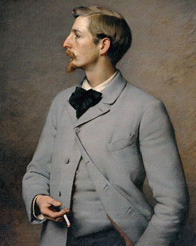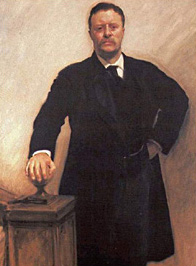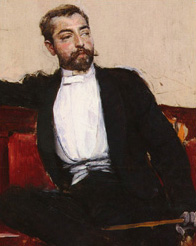Here you can find detailed information on the male clothing word during the late 19th century. For an overview of the clothing worn within the Alienist books, or for detailed information on female and child clothing during the late 19th century, please use the menu.
Male Clothing in the Alienist Books
Undergarments
Tight fitting woolen vests and pants, known as drawers, were usual. They could also be joined to form ‘combinations’.1
Night Wear
Sleeping suits (pajamas in America) were beginning to replace the sleeping shirt by the 1880s, however many conservative, elderly, or country men continued to wear sleeping shirts until around 1910. Pajamas were made from silk or wool, and were often in striped colours.1 Full length dressing gowns were also worn prior to going to bed and upon waking up in the morning.
Neckties
Neckties and cravats were cut during this period so that they were narrower in the centre, where they went around the neck, and widened out at the ends. They were tied in a variety of ways. Popular styles in the 1890s included the sailor’s reef knot, the four-in-hand (a.k.a. the Derby), the floppy bow, or the small neat bow. An example of the floppy bow can be seen to the left. A small white cambric bow tie was worn with formal evening wear. The Oxford tie also gained popularity during this period.1
Shirts
Although working-class men wore shirts of varying colours, gentlemen usually wore plain white. Stripes of blue or pink were also acceptable by the 1890s, provided that the collars and cuffs were white. Collars and cuffs were detachable from the shirt. For formal occasions, collars were winged or single and straight (i.e., turned up) while cuffs were double and fastened with cufflinks. Informal collars were double (i.e., turned over) while informal cuffs were single and visible for about an inch from the coat sleeve. All shirts, collars, and cuffs were highly starched.1
Coats and Jackets
By the 1890s, men’s coats had ‘American’ shoulders which were padded similarly to today. Frock coats and morning coats were common for formal daytime wear. A painting of Theodore Roosevelt wearing a frock coat can be seen to the right. The jacket replaced the coat for informal occasions. For example, the lounging jacket was popular from the 1860s onward. This was “single-breasted and short-skirted, with rounded fronts, flapped pockets on the hips, and a slit or welt pocket on the left breast”1, p.141. Smoking jackets were worn informally around the home. They could be single or double breasted, quilted for extra warmth, and were made of velvet, cashmere, or plush. Reefer and ‘sac’ coats were worn as overcoats.1
Waistcoats
Day waistcoats tended to be matched to the colour of the suit (i.e., a grey suit coat would require a grey waistcoat). Day waistcoats could be either single or double breasted. Formal waistcoats were black and single-breasted, although a double-breasted style was also acceptable by the 1890s.1
Trousers
‘American’ trousers were introduced in 1857 and were popular throughout the second half of the 19th century. They had a narrow waistband with a strap and buckle at the back.1 Another type of trouser had brace buttons around the waistband, two of which were on rising points at the centre back.2 The former type of trouser could be worn with belts; the latter type could only accommodate braces. There was little variation to the cut of trousers during this period and most were reasonably straight to the ankle. In the 1890s, it was also fashionable to have a crease pressed into the front and back of the trousers. This was made possible by the invention of the trouser press.1
Sports Wear
Knickerbockers were usually worn for sporting activities. Norfolk jackets accompanied them for shooting and other country sports. Knee high boots and tweed caps accessorised the outfit. Knitted sweaters with crew or polo necklines were also introduced in the 1890s to take the place of waistcoats for sports such as tennis and golf. Tennis also required the use of canvas or rubber shoes.1
Formal Evening Wear
Tail coats made of fine black cloth were worn for formal evening events, such as balls or the opera. The lapels were faced with silk or velvet. A portrait of John Singer Sargent from the 1890s wearing a tail coat can be seen to the right. A less formal evening coat, known in America as the tuxedo, was introduced in the late 1880s. It was worn for dinner at home or at a club. This was also black, had silk or velvet faced lapels extending down to waist level, cuffed sleeves, and a back that was cut whole. In the 1890s, it only had one button but this was usually left open. Evening coats, with a cape and velvet collar, were worn when travelling to a formal event.1
Hairstyles and Facial Hair
Male hair was cut fairly short during the 1890s, however facial hair was fashionable. Moustaches were common and beards ranged from bushy, to pointed, to rounded, to goatees. In spite of this, the clean-shaven look was also gaining popularity for younger men during this decade.1
Hats
Tall silk and top hats, popular throughout the 19th century, were still fashionable for both formal day and evening wear in the 1890s. Hard felt bowlers, named after their designer William Bowler, were also well-liked. Other popular day hats included the Homburg and the trilby. Boaters were also highly fashionable for both country and seaside wear.1
Shoes
By the 1890s, leather shoes were laced, although elastic-sided ankle boots were not uncommon. Cloth topped buttoned boots were also popular from the 1880s. Most shoes were black or brown, although white was also acceptable for summer wear.1 Informally around the house, men also wore slippers which could be made of a variety of fabrics, including silk and snake skin.2
Socks
Even with white shoes, socks were always black. From the mid-1890s, they were held up by elastic sock-suspenders which sat just below the knee.1
Gloves
Men’s gloves were made of fine kid or chamois and were grey, brown, or black in colour. White gloves accompanied formal evening wear.1
Accessories
By the 1890s, most men carried an expensive, tightly-rolled, silk-covered umbrella instead of a cane. They also wore cufflinks, scarf pins, and watch-chains across the front of their waistcoats. The watch-chains passed through a special chain-hold in the waistcoat and were draped between its pockets. For men who smoked, they carried cigar or cigarette related accessories.1 Money was carried in a billfold.
References
1. Nunn, Joan. Fashion in Costume 1200~2000. 2nd ed. Chicago: New Amsterdam Books, 2000.
2. Johnston, Lucy. Nineteenth-Century Fashion In Detail. London: V&A Publications, 2005.



